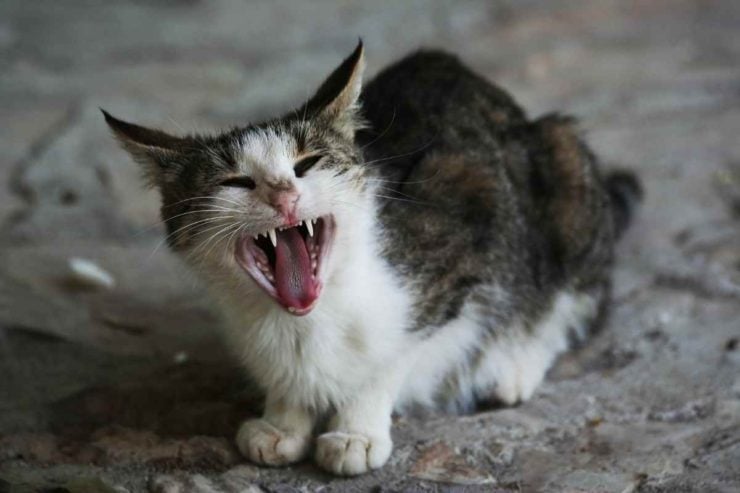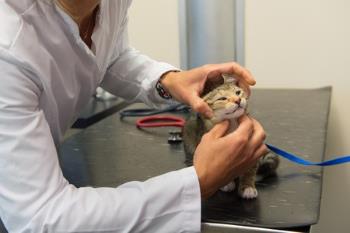Hyperthyroidism is a condition that results from a high metabolism due to the increased production of thyroid hormones. Main signs of hyperthyroidism in cats are low weight, increased appetite, and thirst among many others.

Thyroid hormones are produced by the thyroid gland; the gland’s main function is to regulate metabolism, although the hormones it produces are involved in almost all the functions of your cat’s body. Including breathing, heartbeat, sleep regulation, and the reproductive system.
Hyperthyroidism is among the most common diseases in middle-aged and older cats, and untreated hyperthyroidism can have a lethal outcome. In this article, you will learn how to recognize symptoms of hyperthyroidism in cats and what to do if you suspect your cat might have it.
What are the signs of hyperthyroidism in cats?
Since hyperthyroidism causes an increased metabolism, frequent signs of the disease include increased calorie needs, a higher amount of energy and a faster pace in your cat.
NOTE: Usually cats will display only a few signs listed below, and not all cats will have these symptoms. However, if you notice even a single one of these signs in your cat, it’s a reason to visit a veterinarian – especially because other serious diseases have similar symptoms, too.
The most common symptoms of hyperthyroidism in cats are:
- weight loss – this is usually the first sign of hyperthyroidism that cat owners notice. When a cat’s metabolic rate increases, his caloric requirements also increase significantly. If the additional food intake is not able to compensate for the extra needs, the cat loses weight. See here for more reasons why cats lose weight.
- increased appetite – since caloric needs are higher, a cat’s appetite will also increase. Be aware that weight loss combined with a greater appetite is also a common sign of diabetes in cats. When a cat wants to eat constantly, it may be either a medical or a behavioral problem.
- increased urination and thirst – increased appetite may also be combined with increased thirst. We often say that it’s important to pay attention to your cat’s drinking habits, but you may also notice changes in the litter box. Are clumps in the box larger than usual or is your cat visiting the litter box more frequently?
- diarrhea and vomiting – a higher metabolism also causes increased activity in the intestines, leading to diarrhea. Your cat may vomit because he consumes a large amount of food. Also, his hormonal changes may influence stomach functions.
- increased activity – we’re not talking about a cat just being willing to play more, but about the fact that the cat’s high energy levels prevent him or her from settling down. It’s also common for cats with hyperthyroidism to act aggressively. This is due to the increased metabolism, which also causes other body systems to work at a faster pace, causing a rapid heart rate, difficulty breathing and greater levels of activity.
- increased vocalization – whereas excessive meowing is usually a behavioral problem, it may also indicate certain medical conditions. Often, the cat meows more frequently when he wants to eat more and his needs are not met. Restlessness can also force your cat to vocalize more. Additionally, a cat may meow a lot due to the pain and/or discomfort associated with the disease.
- poor coat – this may have two causes: one, the cat is not grooming itself due to weakness; or two, the cat is overgrooming itself due to stress associated with feeling unwell.
There are also symptoms that only a veterinarian can identify:
 enlarged thyroid gland – a vet may palpate the gland to see if it’s enlarged, and an increase in the size of the thyroid gland can be confirmed by ultrasonography.
enlarged thyroid gland – a vet may palpate the gland to see if it’s enlarged, and an increase in the size of the thyroid gland can be confirmed by ultrasonography.- increased levels of thyroid hormones – hyperthyroidism is by definition an increase of thyroid hormones. Blood tests will confirm this. In some cases, more than one test will be required. Blood tests ensure that a cat owner receives an accurate diagnosis for their cat.
How can one treat hyperthyroidism?
If you suspect your cat may have hyperthyroidism, an immediate visit to the vet is a must. Untreated hyperthyroidism in cats can be lethal but, if diagnosed early (and the underlying cause is not a carcinoma), your cat has a great chance of being treated successfully.
Here are the most common methods of treating hyperthyroidism in cats:
- Anti-thyroid drugs will help your cat’s body to suppress the production of thyroid hormones. Unfortunately, that means pilling your cat regularly for the rest of his life.
- Radio-iodine therapy is a single injection of radioactive iodine. Such treatment has high success rates – up to 98%, according to the University of Cornell, College of Veterinary Medicine. Disadvantages of this kind of treatment are that it’s expensive and not widely accessible. You must also leave your cat at a hospital for a prolonged time.
- Thyroid gland extraction. In this surgery, a veterinarian will remove one or both lobes of your cat’s thyroid glands. This is a final measure, usually when there is a thyroid cancer or when the enlargement or symptoms are severe. After the surgery, there is an increased risk of developing hypothyroidism (too few thyroid hormones) and calcium regulation problems. Also, with this treatment, the cat may develop hyperthyroidism again in the future.
- Iodine restriction diet is a treatment method that uses scientific cat food with a lowered iodine content. The problem with this method is that no-one is yet certain about the number of iodine cats normally need. It also not certain how reducing iodine might affect other body systems.
- Natural treatments are also available, such as flower essences, supporting vitamins, and, as mentioned above, a change of diet to one that is highly digestible. IMPORTANT: Do NOT buy products advertised and sold online as natural treatments for hyperthyroidism in cats. You must discuss this option with a veterinarian before administering treatment.
Even if you have not noticed any of the symptoms of hyperthyroidism in your cat, it’s still a good idea to learn more about the disease, its causes, and, most importantly, ways to avoid it. This is what we are going to talk about next week.
